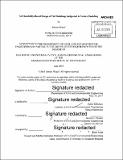Serviceability-based design of tall buildings subjected to vortex shedding
Author(s)
Wasef, Abram
DownloadFull printable version (10.33Mb)
Other Contributors
Massachusetts Institute of Technology. Department of Civil and Environmental Engineering.
Advisor
Pierre Ghisbain and Jerome J. Connor.
Terms of use
Metadata
Show full item recordAbstract
With the increasing rate of population, there is an increase in demand for housing for people and their families. Due to the limited amount of land space, one of the most viable and feasible solutions is increase the number and height of residential and office buildings leading to a requirement of having a special design for these tall buildings. Due to the advancement of technology leading to an increase in the strength of materials used in construction, these types of buildings can be built. This leads to lesser amounts of materials used and resulting in lightweight structures that are flexible. As the height of the buildings increases, these lightweight structures become more flexible making them susceptible to excessive wind-induced motion. Although there are multiple factors that govern serviceability in tall buildings, it has been deduced from the literature, that acceleration is a very important factor, and that as the level of acceleration increases, people become more uncomfortable. Moreover, across wind response caused mainly due to vortex shedding becomes a very important phenomenon that needs to be dealt with, and which also contributes a significant amount of acceleration on the building. Acceleration due to vortex shedding is the focus of this thesis. To determine a solution, information on factors affecting serviceability of tall buildings, how increasing effects of these factors would affect occupants, and how current standards and codes deal with serviceability requirements were obtained. Using this information, a methodology similar to the Pacific Earthquake Engineering Research Center (PEER) criteria was developed to determine the relationship between these different factors. All of these factors were incorporated in different cost functions and combined together to evaluate the serviceability of tall buildings over their lifetime from an economical perspective. A flexible parametric approach was used to analyze how varying the level of damping, stiffness and the negative effects due to wind-induced acceleration will affect the cost of tall buildings. Moreover, a detailed example was presented to show how the methodology works by analyzing the CAARC Building. Also, the analysis includes varying the location by applying the methodology to three different states to determine how stiffness and damping changed.
Description
Thesis: M. Eng., Massachusetts Institute of Technology, Department of Civil and Environmental Engineering, 2015. Cataloged from PDF version of thesis. Includes bibliographical references (pages 95-97).
Date issued
2015Department
Massachusetts Institute of Technology. Department of Civil and Environmental EngineeringPublisher
Massachusetts Institute of Technology
Keywords
Civil and Environmental Engineering.